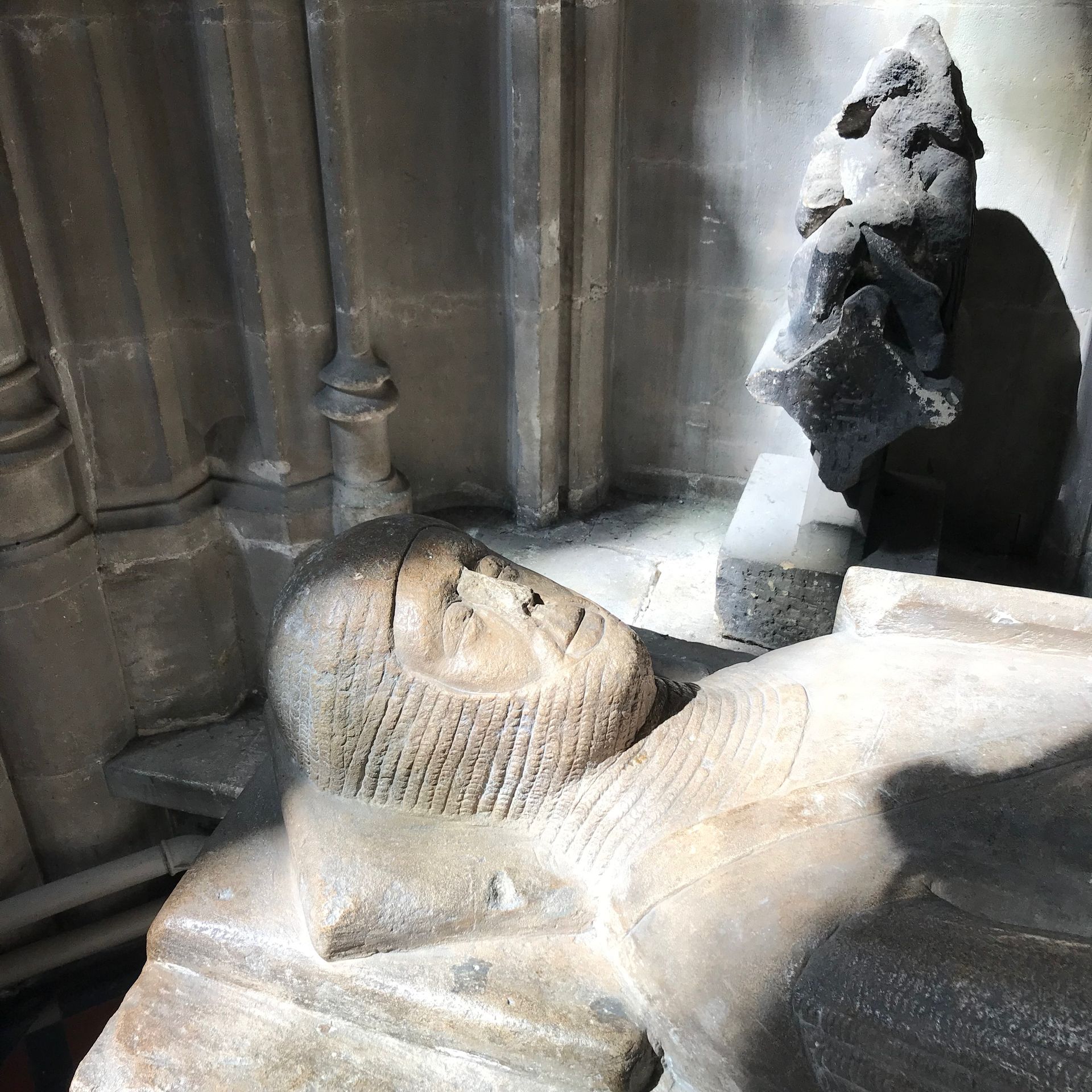The North Transept
The Gift of Water
The North Transept Window
The large central window was formerly dedicated to the slave trader and local benefactor Edward Colston.
In June 2020 the statue of Colston was tipped into the harbour following the death of George Floyd in the USA. By then the church had already stopped using artefacts that were not aligned with its values. As a continuation of this policy, four small panes of glass that explicitly mentioned Colston were removed and replaced with new stained glass designs that are more reflective of the church’s values of compassion, inclusivity and justice.
The Victorian glass that was removed quoted Colston’s family motto of Go thou and do likewise. The line comes from the end of the story of the Good Samaritan, which is pictured in the main window. The new panels will have a quote from the same story: And who is my neighbour? Each of the four new panels encourage the viewer to consider that question for themselves.
Who was Edward Colston?
Edward Colston was a senior figure in the transatlantic trafficking of enslaved Africans. He made his fortune trading in human suffering. Accordingly, the presence of a memorial to Colston was inappropriate because it was inconsistent with the church's values.
Colston was philanthropic towards some people in Bristol, but there is no evidence to suggest that his philanthropy arose from any sense of regret or penitence. As a slave trader and senior official in the Royal African Company from 1680 to 1692, he is estimated to have been involved in the transportation of over 84,000 slaves from West Africa to the Caribbean and Americas.
The new windows
The new panels, which depict Jesus in multiple ethnicities to counter the anglo-centric narrative of ‘white Jesus’, are designed by local doctor Ealish Swift. These are the first images of a non-white Jesus to be installed in St Mary Redcliffe Church and join two other windows which feature non-white characters.
Medieval recumbent effigy of a knight
No-one knows who this figure represents but it is certainly one of the oldest pieces in the church, probably predating most of the current church building. In traditional histories of the church the figure has been associated with Simon de Burton (one of the supposed founders of the church) or, more commonly, Lord Robert de Berkeley who gave a supply of fresh water to the church around 1190 and who is buried in Bristol Cathedral.
Sir Robert de Berkeley, Baron (b. c. 1165 d. 1220)
Sir Robert de Berkeley (whose justified nickname is "Robert the Rebellious") was educated at the court of King Henry II. He became Lord de Berkeley as a feudal baron in 1190 (confirmed in 1198 - such things involved a long process in those days). Robert sided with the rebellious barons against King John but was fortunate in receiving a subsequent pardon for his disloyalty to the monarch in 1214. Despite this, he once again took part in a rebellion, resulting in his excommunication for a while. That was removed when he paid £966 in 1216. He also regained most, though not all, of his lands then his estate at Berkeley in Gloucestershire was not returned to him). After his death in 1220 he was buried at St Augustine's Abbey (now Bristol Cathedral), meaning that St Mary Redcliffe cannot be de Berkeley's final resting place.
The gift of water
Bristol was founded in the late Saxon period and became the second most prosperous city in England (only London surpassed it). In common with similar cities, Bristol earned much of its living from its city centre port and the area of Redcliffe was at the very heart of medieval port life in the city. However, just because a place made its living from seamanship did not mean it had one of the most essential items for life - fresh, clean, drinking water. So, the gift of fresh water to the parish in the 12th century was literally a matter of life and death.
The Lord of the Manor of Bedminster, Sir Robert de Berkeley, gave St Mary Redcliffe a water supply and the land through which it was to be piped, allowing clean fresh spring water to flow from its source two miles away and emerge at the edge of the south churchyard on Redcliffe Hill.
The Pipe Walk
Every year the Priest, Churchwardens and people of St Mary Redcliffe walk the route of the ancient conduit and give thanks for the gift of fresh water. The historic event asserts the church’s right of way along the 2,514 metre (2,750 yard) route of an 824-year-old pipeline linking it with an ancient fresh water spring in the Knowle area of Bristol.
Find out more about the Pipe Walk here.
The Chaotic Pendulum
The Chaotic Pendulum was installed in 1997 as part of the church's Journey Into Science Project, inspired by Dr Eric Albone. The machine was devised by the late Prof Sir Brian Pippard FRS for his inaugural lecture as Cavendish Professor of Physics at Cambridge University in the 1970s. The pendulum was built by Robert Knight and sponsored by Bristol Water plc.
The pendulum demonstrates the beautiful random nature of our universe (the "chaos theory").
Water, constantly recycled around the pendulum, slowly flows into the hollow metal tube at the cross beam. This eventually tips to let the water flow out but with all the science we have, no-one can predict exactly how the movement will go - there is no pattern to this tipping, it is purely random. Science does not offer certainties about everything. The world is a more wonderful and surprising place than we could have imagined.
St Mary Redcliffe's Journey Into Science project offers a forum for the whole community to come together to discuss, wonder at, question and think about the issues advances in science and technology are raising for our world.


